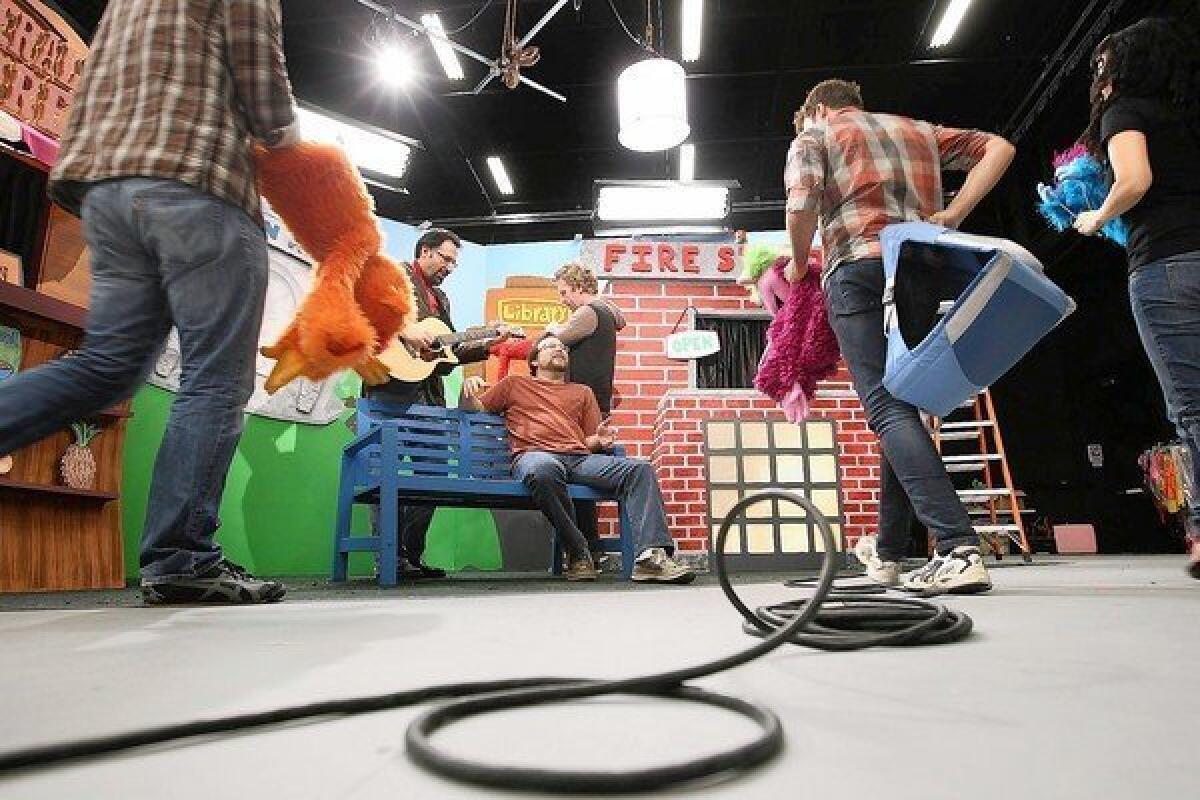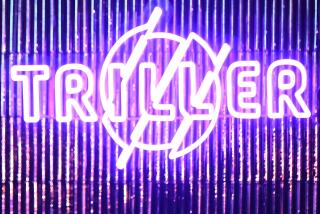YouTube gets its Space in place

In a Playa Vista aircraft hangar that turned out Army helicopters during the Vietnam War, an actor wearing a multicolored princess gown, tiara and wand waits for a crew of about 25 to finish lunch and resume filming.
The building that once was part of Howard Hughes’ sprawling Hercules complex, where the famous Spruce Goose was assembled during World War II, now provides a setting for another kind of American innovation — YouTube videos.
The Google Inc. division has converted the 41,000-square-foot hangar into a state-of-the-art digital production facility that is believed to be one of the largest in Southern California devoted exclusively to content distributed online. It provides YouTube’s partners access to cinema stages, professional-grade equipment, production facilities such as green-screen stages and a motion-capture room, and a Hollywood-worthy screening room, all to help them create more polished entertainment. Creators will get their first look at the new YouTube Space Los Angeles at an open house Wednesday.
“Everything about this facility is about putting creators in settings that they may not have been in before,” said Liam Collins, head of the YouTube Space. “The facility is all about being more ambitious with your content, and this is a place where you can see the possibilities.”
YouTube’s studio, which a person familiar with the project said represented nearly $25 million in improvements, is emblematic of Silicon Valley’s growing influence in the entertainment industry at a time when traditional film and television production has been leaving Los Angeles. Indeed, it selected the same Playa Vista site where DreamWorks SKG once proposed building its own backlot until it abandoned those plans in 1999.
The investment by the Internet’s dominant distributor of video is just the latest in a series YouTube initiatives to foster a vibrant and skilled creative community. In recent years it has cultivated its most promising channel partners, holding panel discussions and publishing an online compendium of best practices dubbed the “YouTube Creator Playbook.” Development programs such as YouTube NextUp and Next Creator have provided training for some 215 motivated creators from 15 countries in genres including comedy, news, education and cooking.
For the last year, YouTube has been moving aggressively to support partners and the content they create, including a $100-million investment in programming. Recently, the company began evaluating its funding of 100 original channels to decide which will receive a subsequent round of backing. The site expects that 40% of these programmers will get fresh financing.
This wealth of resources is available — for free — to YouTube’s creators. “What we’ve learned over the last couple of years is the act of bringing creators together causes good thing to happen,” said Tom Pickett, vice president of global content operations for YouTube. “They cross-promote each other, they teach each other, they crew for each other. There really is this community element to being YouTube creators. In a few markets, we want to see if we can help facilitate that.”
YouTube has opened similar creator spaces in New York and London, and an additional one is slated to open in Asia. In Los Angeles, it anticipates admitting at least 25 YouTube channels into classes each quarter, starting in January. Applicants will propose a project, and YouTube will evaluate the candidates based on a channel creators’ commitment to the platform, dedicated resources and willingness to collaborate.
“Assuming you’re accepted, we’ll give you the resources that you requested,” said Collins. “But you’ll also get carte blanche to come into this building any time during that quarter. The idea is we really want to incentivize creators to hang out here, spend time and interact with each other.”
The notion of fostering community was a paramount consideration for YouTube, whose executives hope the facility will do for digital video what CBGB, a scrappy downtown New York City club, did for American punk rock in the ‘70s and ‘80s — namely, propel the careers of some of the most influential bands of that era, including Blondie, the Patti Smith Group and Talking Heads.
“The idea was to create a facility that could, on the one hand, completely support the technical goal — which was to raise the bar for these partners, to allow them to do things they couldn’t possibly do shooting in their living rooms,” said Keith Hanadel of the New York architectural firm HLW International. “But at the same time, give them a larger creative community that they could rub up against.”
HLW designed YouTube’s Playa Vista space and its Beverly Hills offices as well as the update of Google’s offices in Frank Gehry’s giant binoculars building in Venice. Google employs about 500 people in Los Angeles, including about 50 at YouTube.
The spacious lobby at YouTube’s production facility serves as its main public meeting place.
The entry is dominated by wall of 36-screen interactive monitors hanging above the reception desk, displaying videos — think of it as YouTube’s version of the Times Square Jumbotron in New York. A recording studio at the far end of the lobby allows visitors to observe recording sessions through a wall of glasspanes. And an elevated screening room, which looks like a raised box with a glass wall, looms above the lounge area, which is filled with colorful couches and chairs, a collaboration desk, an arcade area and small kitchen.
Throughout, Hanadel tucked in cozy private meeting spaces — placing couches in areas along the main corridor (and above, in elevated crow’s-nests) where creators could hold a script workshop, chat or read a book.
The most striking element — aside from the juxtaposition of modern furniture and contemporary lighting in the historic space, where the exposed beams hint at its earlier, industrial heritage — is its use of natural light.
“We wanted to take advantage of what for us, as East Coast people, is this amazing resource on the West Coast — this beautiful, steady light,” Hanadel said. “We wanted to flood it into the place. At the same time, we needed to control it. That meant we pushed all the production facilities against the south wall and we opened up the north wall.”
In addition to the technical resources YouTube plans to bring in experts drawn from YouTube and the broader Hollywood community. It is recruiting a handful of successful channel creators to serve in a longer-term residency program, in which they would teacher and mentor upcoming creators.
Freddie Wong, who together with Brandon Laatsch created one of the most popular channels on YouTube, the FreddieW Channel, is contemplating taking up temporary residency in the space — perhaps for a new YouTube project or production of a second season of “Video Game High School,” an action-comedy series in which the best young gamers are recruited by elite boarding schools to sharpen their skills.
“I’d very much like to teach classes here, because it’s the kind of thing we like to do,” said Wong. “We’re very instructional, because at the end of the day we know there are people out there like us. When we were teenagers, we were going through the special features on DVDs and trying to figure out how they did things. Now, it’s like, ‘Hey, we have this knowledge. Let’s share.”’
Kim Evey, who together with “The Guild” star Felicia Day founded the YouTube channel Geek & Sundry, was given early access to YouTube’s space to produce a new Web musical, “Learning Town.” The 10-episode series revolves around comedic musical duo Paul and Storm’s (Paul Sabourin and Gregory “Storm” DiCostanzo) attempts to revive a flagging children’s show as they battle a hipster-run rival kid’s program, their own incompetence and lots of flammable puppets.
On a recent Friday afternoon, the “Learning Town” production filled a large cinema stage. Storm and guest star Freda Foh Shen spoke with director Sean Becker on the set, as a full production crew of grips, makeup artists, wardrobe and props people, cameramen and sound engineers waited to resume production.
As a Web producer, Evey has worked in far less professional settings — including shooting two seasons of her Web show, “Gorgeous Tiny Chicken Machine Show,” out of her garage.
“We have probably 50 people every day, including actors and sometimes extras. So just being able to come to work every day and know where you’re going to be, know where you’re setting up, know where everybody is — it’s much easier,” Evey said. “That’s the biggest complication with production, when you’re moving around, every single time you have to figure out, ‘Where do we put everybody?’ We’ve done things before where it’s such a puzzle.”
MORE
INTERACTIVE: TVs highest paid stars
PHOTOS: Hollywood back lot moments
More to Read
Start your day right
Sign up for Essential California for news, features and recommendations from the L.A. Times and beyond in your inbox six days a week.
You may occasionally receive promotional content from the Los Angeles Times.






